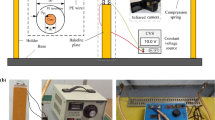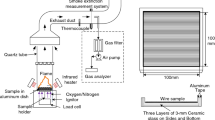Abstract
Ignition of energized polyvinyl chloride insulated copper conductor wires by external heating was investigated for a better understanding of the initiation of electrical wire fires. First, a simplified theoretical analysis was developed to quantitatively explain the effects of currents on the ignition of electrical wires. The numerical result predicted that the ignition time concavely decreases with the increasing external heat flux while convexly decreasing with the increasing current of wire. Second, experiments with several sample wires were conducted to study the ignition process. It showed a good consistency between the experimental and numerical results. Using the methods of Transmission Electron Microscope, Scanning Electron Microscope and Fast Particulate Spectrometer, the properties of released smoke productions were obtained. The smoke particles size distribution was found independent to the current of wire and showed the same morphology with the standard test fires. The properties of pyrolysis smoke particles showed a two-regime behavior with the increasing current of wire. The pyrolysis smoke particle size distribution with one certain current showed a bimodal phenomenon. The three-stage changes of the count median diameter and geometry mean diameter were also presented.











Similar content being viewed by others
Abbreviations
- \( d \) :
-
Diameter (m)
- \( \delta \) :
-
Thickness (m)
- \( L \) :
-
Length of heating zone (m)
- \( A \) :
-
Area (m2)
- \( \rho \) :
-
Density (kg/m3)
- \( \lambda \) :
-
Thermal conductivity (W/m/K)
- \( c \) :
-
Specific heat (kJ/kg/K)
- \( h \) :
-
Heat transfer coefficient (W/m2/K)
- \( \dot{q}^{\prime\prime}_{e} \) :
-
External heat flux per unit area (kW/m2)
- \( I \) :
-
Current (A)
- \( T \) :
-
Temperature (K or °C)
- \( R^{\prime} \) :
-
Electrical resistance per unit length (\( \Omega/\text{m} \))
- \( Bi \) :
-
Biot number
- \( r \) :
-
Radius (m)
- c :
-
Core
- p :
-
Insulation
- w :
-
Wire
- ch :
-
Coil heater
- ig :
-
Ignition
- o :
-
Outer surface
- a :
-
Ambient
- b :
-
Balance
References
U.S. Fire Administration (2014) Residential building electrical fires (2009–2011). Top Fire Rep Ser 14:1–11.
Keski-Rahkonen O, Mangs J (2002) Electrical ignition sources in nuclear power plants: statistical, modelling and experimental studies. Nucl Eng Des 213:209–221.
Babrauskas, Vytenis, FSFPE (2010) Electrical fires: research needed to improve safety. Fire Protection Engineering, Springer, New York. pp 20–30.
Thomas E (1992) Electric services and building fires. Fire Technol 28:70–86.
Andersson P, Rosell L, Simonson M, Emanuelsson V (2004) Small and large scale fire experiments with electric cables under well-ventilated and vitiated conditions. Fire Technol 40:247–262.
Babrauskas V (2006) Mechanisms and modes for ignition of low-voltage, PVC-insulated electrotechnical products. Fire Mater 30:151–174.
Harriman L (2002) Environmental, health and safety issues in the Coated Wire and Cable Industry, Technical Report No.51. The Massachusetts Toxic Use Reduction Institute: Lowell, MA.
Umemura A, Uchida M, Hirata T, Sato J (2002) Physical model analysis of flame spreading along an electrical wire in microgravity. Proc Combust Inst 29:2535–2543.
Fujita O, Kyono T, Kido Y, Ito H, Nakamura Y (2011) Ignition of electrical wire insulation with short-term excess electric current in microgravity. Proc Combust Inst 33:2617–2623.
Nakamura Y, Yoshimura N, Ito H, Azumaya K, Fujita O (2009) Flame spread over electric wire in sub-atmospheric pressure. Proc Combust Inst 32:2559–2566.
Huang X, Nakamura Y, Williams FA (2013) Ignition-to-spread transition of externally heated electrical wire. Proc Combust Inst 34:2505–2512.
Hu L, Zhang Y, Yoshioka K, Izumo H, Fujita O (2015) Flame spread over electric wire with high thermal conductivity metal core at different inclinations. Proc Combust Inst 35:2607–2614.
Cahill P (1995) Electrical short circuit and current overload tests on aircraft wiring. USDT, DOT/FAA/CT-TN94/55. Federal Aviation Administration Technical Center, Atlantic City.
Thibert E, Gautier B (1999) Combustion of an electrical cable insulation: thermal study and modelling at EDF. Polym Degrad Stab 64:585–593.
Babrauskas V (2003) Ignition handbook. Fire Science Publishers/Society of Fire Protection Engineers, Issaquah.
Xie Q, Zhang H, Tong L (2010) Experimental study on the fire protection properties of PVC sheath for old and new cables. J Hazard Mater 179:373–381.
Cameron JN, Stanislav IS, Michael RK, James GQ (2013) An analysis of heat flux induced arc formation in a residential electrical cable. Fire Safety J 55:61–68.
Fisher RP (2013) An analysis of thermally induced arcing failure of electrical cable. University of Maryland, College Park, MD.
Linteris GT (2011) Clean agent suppression of energized electrical equipment fires. Fire Technol 47:1–68.
Cai J, Lu N, Sorensen CM (1993) Comparison of size and morphology of soot aggregates as determined by light scattering and electron microscope analysis. Langmuir 9:2861–2867.
Koylu UO, Faeth GM, Farias TL, Carvalho MG (1995) Fractal and projected structure properties of soot aggregates. Combust Flame 100:621–633.
Park K, Kittelson DB, McMurry PH (2004) Structural properties of diesel exhaust particles measured by transmission electron microscopy (TEM): relationships to particle mass and mobility. Aerosol Sci Tech 38:881–889.
Suo-Anttila J, Gill W, Gritzo L, Blake D (2005) An evaluation of actual and simulated smoke properties. Fire Mater 29:91–107.
Keller A, Loepfe M, Nebiker P, Pleisch R, Burtscher H (2006) On-line determination of the optical properties of particles produced by test fires. Fire Safety J 41:266–273.
Butler KM, Mulholland GW (2004) Generation and transport of smoke components. Fire Technol 40:149–176.
Xie Q, Yuan H, Song L, Zhang Y (2007) Experimental studies on time-dependent size distributions of smoke particles of standard test fires. Build Environ 42:640–664.
Brandrup J, Immergut EH, Grulke EA, Abe A, Bloch DR (2005) Polymer handbook. 4th edn. Wiley, New York.
Alenitsyn AG, Butikov EI, Kondraryez AS (1997) Concise handbook of mathematics and physics. CRC Press, Boca Raton.
Wu C, Chang C, Hor J, Shih S, Chen L, Chang F (1994) Two-stage pyrolysis model of PVC. Can J Chem Eng 72:644–650.
Knuemann R, Bochhorn H (1994) Investigation of the kinetics of pyrolysis of PVC by TG-MS-analysis. Combust Sci Technol 101:285–299.
Bacaloglu R, Fisch M (1995) Degradation and stabilization of poly (vinyl chloride): V. Reaction mechanism of poly (vinyl chloride) degradation. Polym Degrad Stab 47:33–57.
Nandini C (1994) Thermal decomposition of poly (vinyl chloride). J Polym Sci Pol Chem 32:1225–1337.
Park SH, Lee KW, Otto E, Fissan H (1999) The log-normal size distribution theory of Brownian aerosol coagulation for the entire particle size range: Part 1-analytical solution using the harmonic mean coagulation kernel. J Aerosol Sci 30:3–16.
Zimmerman N., Pollitt K. J. G., Jeong, C. H., Wang J. M., Jung T., Cooper J. M., Wallace J. S., Evans G. J. (2014) Comparison of three nanoparticle sizing instruments: The influence of particle morphology. Atmos Environ 86: 140–147.
Vu T. V., Delgado-Saborit J. M., Harrison R. M. (2015) Review: Particle number size distributions from seven major sources and implications for source apportionment studies. Atmos Environ 122: 114–132.
Ruzer L. S., Harley, N. H. (Eds.). (2012) Aerosols handbook: measurement, dosimetry, and health effects. CRC press, Boca Raton. p. 567.
Boucher, O. (2015) Atmospheric Aerosols: Properties and Climate Impacts. Springer, NewYork. pp 25–26.
Helsper C, Fissan H (1980) Particle number distributions of aerosols from test fires. J Aerosol Sci 11:439–446.
Tamm E, Mirme A, Sievert U (1999) Aerosol particle concentration and size distribution measurements of test-fires as a background for fire detector modeling. Proc AUBE 99:150–159.
Acknowledgements
This work was supported by the Joint Funds of the National Natural Science Foundation of China under Grant No. U1233102, the National Program on Key Basic Research Project of China under Grant No. 2012CB719702, and the Collaborative Innovation Center of City Public Safety of Anhui Province. The authors gratefully acknowledge all of this support.
Author information
Authors and Affiliations
Corresponding authors
Rights and permissions
About this article
Cite this article
He, H., Zhang, Q., Wang, X. et al. The Influence of Currents on the Ignition and Correlative Smoke Productions for PVC-Insulated Electrical Wires. Fire Technol 53, 1275–1289 (2017). https://doi.org/10.1007/s10694-016-0634-y
Received:
Accepted:
Published:
Issue Date:
DOI: https://doi.org/10.1007/s10694-016-0634-y




